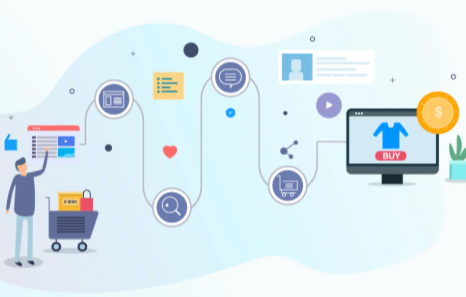What Is the Customer Journey and Why It Matters for Marketers

The customer journey is the complete path a consumer takes from first encountering a brand to becoming a loyal advocate. It encompasses every interaction, decision, and emotion that shape their experience, from initial awareness to post-purchase engagement. For marketers, understanding this journey is not just a strategic advantage—it’s a necessity. By mapping the stages of the customer journey, businesses can craft targeted campaigns, optimize touchpoints, and build lasting relationships. This article delves into the essence of the customer journey and its critical importance for marketers aiming to thrive in a competitive landscape.
Defining the Customer Journey
At its core, the customer journey is a framework that captures the sequence of steps a consumer navigates when engaging with a brand. These steps typically include awareness, consideration, decision, purchase, retention, and advocacy. Each stage reflects a distinct phase of the consumer’s mindset, influenced by their needs, preferences, and external factors like marketing messages or peer recommendations.
Unlike a linear process, the customer journey is dynamic, often looping back as customers re-evaluate options or deepen their loyalty. For example, a consumer discovering a new coffee brand through an X post might research its products, make a purchase, and later share their experience online, influencing others. Marketers must recognize this fluidity to align strategies with real-world consumer behavior.
The Stages of the Customer Journey
To understand why the customer journey matters, it’s essential to break down its key stages and their implications for marketing:
Awareness: This is the moment a consumer first encounters a brand, often through ads, social media, or word-of-mouth. For instance, a traveler might see a targeted ad for a boutique hotel while browsing online. Marketers must create compelling, memorable content to capture attention in this crowded phase.
Consideration: Here, consumers identify a need and explore solutions, researching products or services. A parent looking for a stroller might compare brands, read reviews, or check X for user feedback. Marketers can support this stage with educational content like guides or videos that position their brand as a trusted option.
Decision: Consumers narrow their choices and commit to a purchase. A shopper choosing a laptop might weigh price, features, and reviews before deciding. Clear calls-to-action, transparent pricing, and trust signals like customer testimonials are critical here to reduce friction.
Purchase: The transaction itself is a pivotal moment. A seamless checkout process for an online clothing store can reinforce trust, while a clunky interface might lead to cart abandonment. Marketers must ensure this stage is intuitive and positive to solidify the customer’s choice.
Retention: Post-purchase engagement determines whether a customer returns. A fitness app user who receives helpful onboarding emails or personalized workout tips is more likely to stay engaged. Marketers should focus on support, follow-ups, and loyalty incentives to maintain satisfaction.
Advocacy: Satisfied customers become brand advocates, sharing their experiences through reviews or social posts. A delighted restaurant patron might post a glowing review on X, attracting new customers. Marketers can encourage advocacy with incentives or shareable content.
Why the Customer Journey Matters
The customer journey is a vital tool for marketers because it provides a lens to understand and influence consumer behavior. Here’s why it’s indispensable:
Drives Strategic Focus: Mapping the journey helps marketers identify where to allocate resources. For instance, if data shows high drop-off during the consideration stage, a brand might invest in better product comparisons or customer reviews to address hesitations.
Enhances Personalization: Understanding each stage allows marketers to tailor messages to specific needs. A skincare brand might send educational content to consumers in the consideration phase and loyalty discounts to repeat buyers, ensuring relevance at every step.
Improves Customer Experience: By analyzing touchpoints, marketers can eliminate pain points—like a confusing checkout process—and enhance positive interactions. This focus on experience builds trust and increases retention.
Boosts ROI: Targeted campaigns informed by the customer journey reduce wasted ad spend. For example, a retailer using AI to target ads based on browsing behavior can achieve higher conversion rates than a generic campaign, maximizing return on investment.
Fosters Loyalty and Advocacy: A well-managed journey turns customers into advocates, amplifying brand reach organically. Satisfied customers sharing their experiences on platforms like X can spark new journeys, creating a virtuous cycle.
Leveraging AI to Map the Journey
AI enhances marketers’ ability to navigate the customer journey by providing deep insights and scalability. Machine learning analyzes data from sources like website visits, purchase patterns, and X posts to create detailed customer profiles. For instance, a sports brand might use AI to identify runners who engage with marathon content, tailoring ads for running gear to this group. Predictive analytics can also forecast which customers are likely to churn, enabling proactive retention strategies like personalized offers.
AI’s real-time capabilities allow marketers to adapt campaigns dynamically. If a travel company notices a surge in searches for beach destinations, it can adjust ad targeting to focus on coastal resorts, ensuring relevance. By integrating AI, marketers can map the customer journey with precision, delivering the right message at the right time.
See Also: From Hobby To Healing: Investigating The Function Of OP Techniques
Overcoming Challenges in Journey Mapping
While the customer journey offers immense value, it comes with challenges. Data silos can obscure a holistic view, requiring integrated systems to track interactions across channels. Privacy concerns also demand transparency—marketers must comply with regulations like GDPR and clearly communicate data usage. Additionally, over-focusing on one stage, like acquisition, can neglect retention or advocacy, undermining long-term success.
To address these, marketers should adopt a balanced approach, using tools like customer relationship management (CRM) systems and AI analytics to unify data and maintain ethical practices. Regularly updating journey maps to reflect changing consumer behaviors ensures strategies remain effective.
Shaping Smarter Marketing Strategies
The customer journey is more than a theoretical model—it’s a strategic compass for marketers. By understanding each stage, from awareness to advocacy, businesses can craft campaigns that resonate, reduce friction, and build trust. AI amplifies this process, offering insights and scalability to reach audiences with precision. In a world where consumer expectations are higher than ever, mastering the customer journey enables marketers to not only meet but exceed those expectations, driving conversions, loyalty, and sustainable growth. It’s not just about reaching customers—it’s about guiding them through a meaningful, memorable experience that keeps them coming back.





